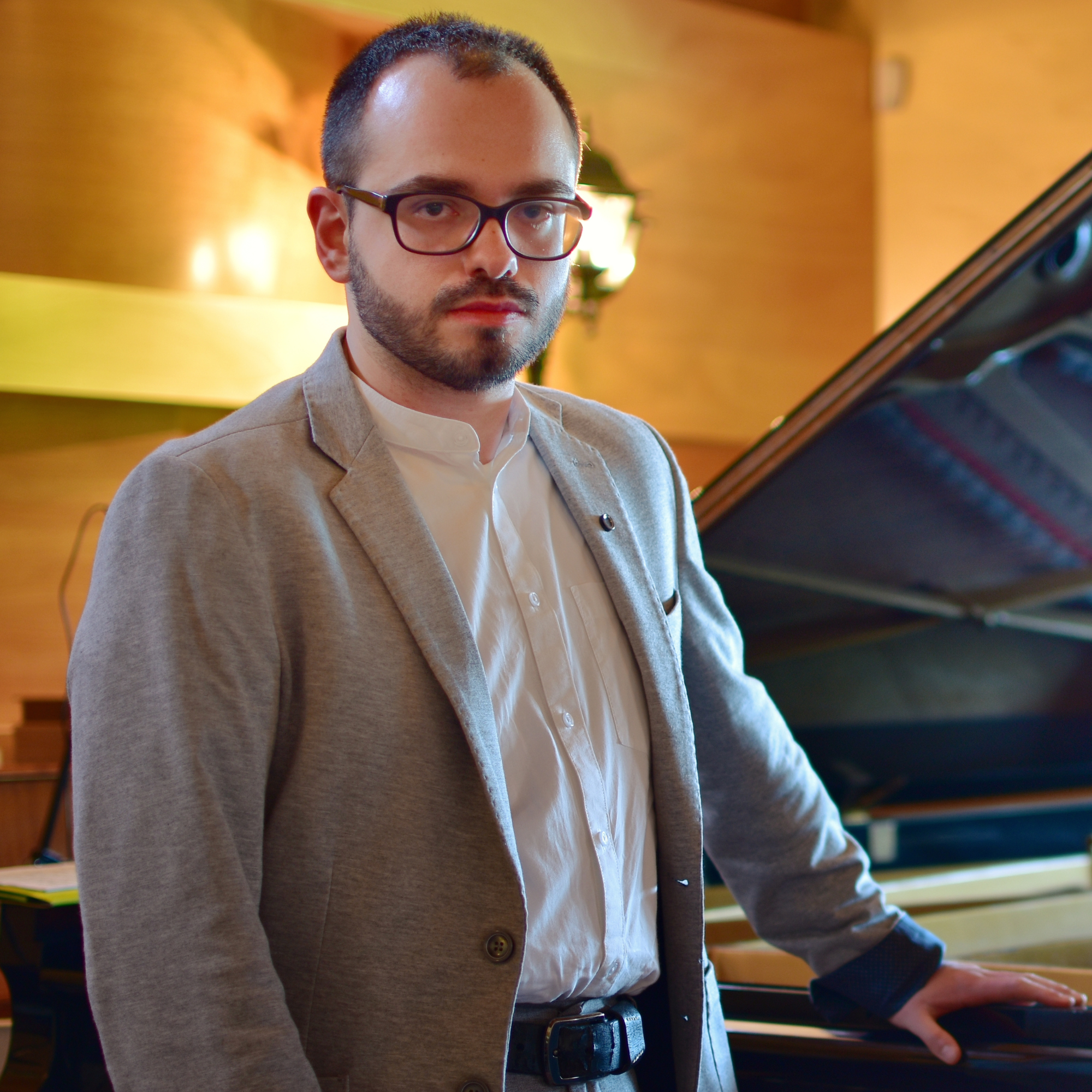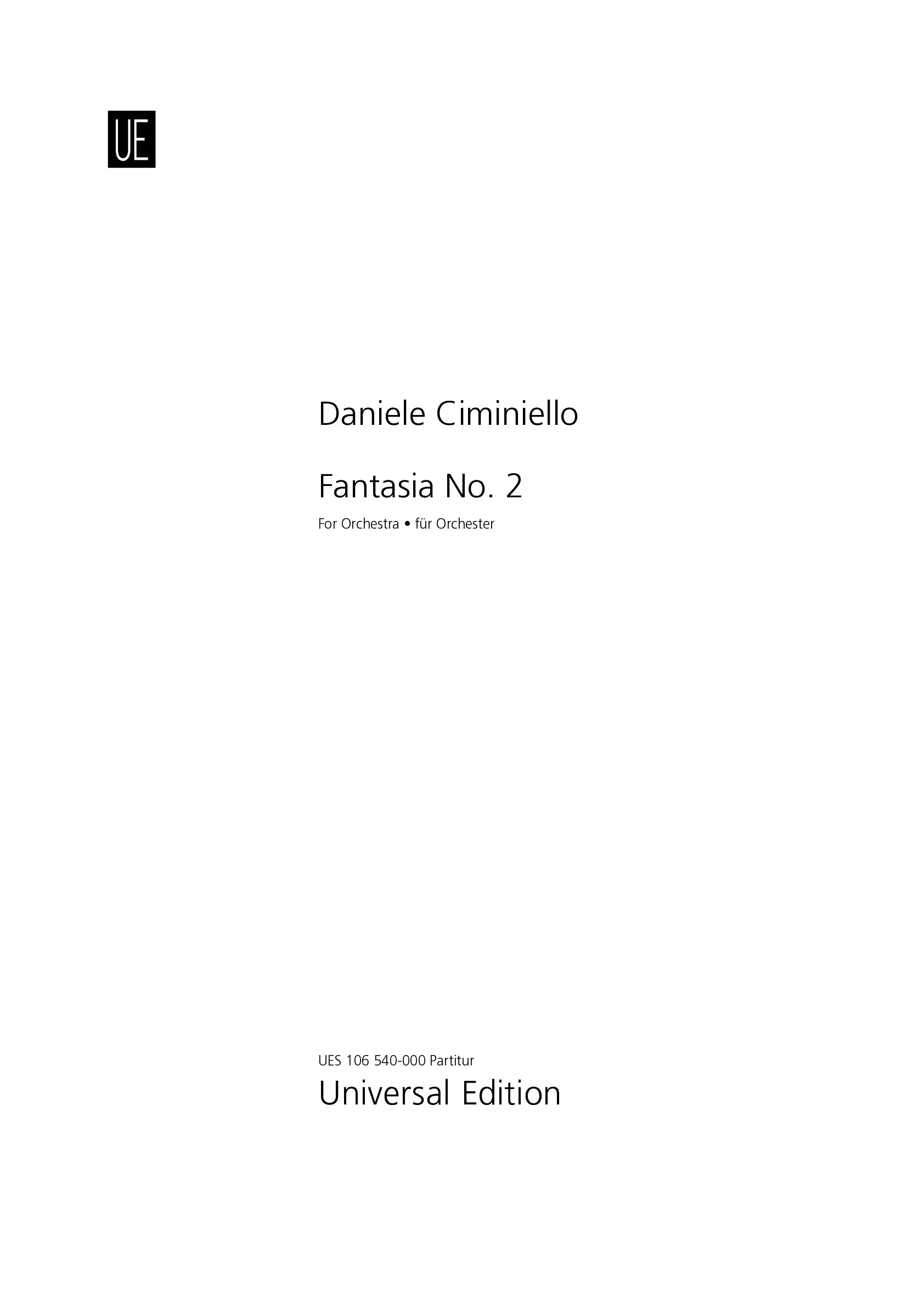

Daniele Ciminiello
Fantasia No. 2
Short instrumentation: 2 2 2 2 - 4 2 2 1, timp, perc, hp, pno, str
Duration: 10'
Instrumentation details:
1st flute
2nd flute
1st oboe
2nd oboe
1st clarinet in Bb
2nd clarinet in Bb
1st bassoon
2nd bassoon
1st horn in F
2nd horn in F
3rd horn in F
4th horn in F
1st trumpet in Bb
2nd trumpet in Bb
1st trombone
2nd trombone
tuba
timpani
percussion
harp
piano
violin I (16 players)
violin II (14 players)
viola (12 players)
violoncello (10 players)
double bass (8 players)
Fantasia No. 2
Printed/Digital
Translation, reprints and more

Daniele Ciminiello
Fantasia No. 2Orchestration: For Orchestra
Type: Dirigierpartitur
Sample pages
Video
Work introduction
“Fantasia No. 2” is a very important milestone in my research for stylistic contamination between distant musical genres. The first version of this piece was for synthesizers only and was inspired by progressive rock and metal bands. In a second stage I started experimenting with mixing synthesizers and orchestral instruments. At the end I decided to re-arrange the piece for orchestra only, developing the musical elements through orchestral writing techniques. As I result, I got a contemporary classical music work which keeps the character and the “groove” of its original version.
The piece is structured along the lines of the overarching sonata form, since each section is long enough to behave like a single movement, perception made even more real by the fact that all sections end with a general pause. The harmonic structure is somehow tonal, with the F as main tonic, but it doesn't follow the traditional functional harmony. It uses instead my own system of octatonic scales for most of the piece and the modal lydian scale for the second theme. I actually developed this system after the completion of this work, so here has been only partially applied, but it has enormous importance for the overall sound of the piece.
The Exposition section (bar 1-108) starts with the presentation of the first theme, which has a rhythmic, percussive and lively character, and it's built on an ostinato bass with a quite complex harmonic structure and continuously changing time signatures. The harmonic structure of the theme alternates two different octatonic scales both built on F. From bar 41 starts the transition, which uses the melodic material of the first theme starting a series of modulations which gradually lead to the dominant key. The orchestration in this part is intentionally fragmented, treating each instrumental family as a separate group such creating a continuos dialogue. The first theme ends at bar 69 with a general pause preceded by a short codetta (bar 59-68). Here the strings play in octave, while woodwinds, brasses and percussions mark the main accents of the pattern. At bar 70 the second theme starts. This theme, “dolce e cantabile”, is in stark contrast to the previous one. The harmonic structure of the theme, as mentioned before, is built on a lydian scale, which creates the ambiguity of a G major that nevertheless is never clearly stated, such creating what I call a “floating melody” whose perception is supported by the delicate orchestration. The theme is at first performed by the horns, accompanied by strings and harp, and afterwards is performed by the first violins. The second theme ends at bar 107 and is followed by a general pause.
The Development section (bar 109-161) starts with a new version of the connection episode (bar 109-118). From bar 119 the development's theme appears. This theme has been created merging the rhythm and the harmonic structure of the fist theme with the melodic profile of the second theme. The brasses, along with percussions, are the main instruments in this section, where the key is never settled through continuous modulations. A new element appears at bar 131: it's a ten notes scale orchestrated with a micro-polyphonic texture which involves woodwinds, piano, harp and strings. This element will come back often at the end of phrases and periods, such acquiring an important syntactic function. At bar 152 the tonal centre goes back to F, preparing the next section.
In the Recapitulation section (162-241) all the material introduced in the Exposition is repeated with some variations, and with the addition of the micro-polyphonic scale which enriches the syntactic structure of the piece. The second theme is repeated in F lydian, left to the trumpets at first, and afterwards to the whole orchestra. The repetition of the second theme in F follows the tradition of the sonata form which wants the second theme in the dominant's key in the Exposition and in the tonic's key in the Recapitulation.
The Coda (242-317) is quite a long section which states as a new Development, but with the urgency typical of a closing section. The melodic material, played by trumpets and trombones, derives from the Development's theme, but with a more stable metric structure. The micro-polyphonic scales become an ostinato that at first is in the high range of the orchestra, played by flutes, clarinets, piano and violins, while from bar 258 moves to the low range, played by bassoons, horns, piano, cellos and double basses. At bar 272 the connection episode is developed with a faster rhythm and an harmonic progression with continuous modulations. At bar 291 the second theme is proposed with a brand new harmonic structure made with an octatonic scale built on F and with a majestic character. This is the first and only time that the orchestra is used with a tutti texture. This section ends with a oboe solo that leads to the last part of the Coda (306-317). Here the tempo is very slow and the F is once for all stated as the main tonic of the piece thanks to a double tonic pedal in the extreme low and high range of the orchestra. A slow ostinato played by piano and harp accompanies a series of chords played by harp, first and second violins. The key of F minor is finally affirmed, with the sound that smoothly fades away closing the piece.
